Table of Contents
Black Molly Overview
As the name of Black Molly itself suggests that they are black. Black Molly fish was born with a lack of color pigmentation, although some show a yellow stripe from the dorsal fin.
Black molly fish are difficult to locate in the wild because they obtained their distinctive characteristics from captive breeding. The black molly fish is native to Central and South America, where it prefers freshwater habitats. However, the breeds also adapt to salty aquatic habitats.
| Information Chart | Black Molly |
| Scientific Name: | Poecilia sphenops |
| Family: | Poeciliidae |
| Care Level: | Easy |
| Temperament: | Peaceful fish |
| Color: | Black |
| Lifespan: | Up to 5 years |
| Size: | Up to 4.5 inches |
| Diet: | Omnivorous fish |
| Minimum Tank Size: | 10 gallons |
| Temperature: | 70 to 79°F (21 to 26°C) |
| WaterConditions: | pH 7.0 to 8.520.0 to 35.0 dGH |
| Tank Mate Compatibility | Peaceful community aquarium |
Black Molly Appearance

If you think of a Black Molly fish, generally, the image of the Common Molly comes to mind. However, various species out there have an identical pattern and style of the body to the Common Molly.
Black Molly fish has a smoothed body with a head in a triangular shape. On the other end, the body fades barely towards the root of the shape of a fan-like tail.
Lifespan Of Black Molly
The typical lifespan of a Black Molly is 3-5 years. However, black Mollies are not the ones who live a long life; there is some waggle area relying on what breeds you receive.
The integrity of supervision you give to your Black Molly fish would also affect its lifespan considerably. Since Black Mollies are generally healthy, they are likely to infect only from an inadequately sustained habitat.
Black Molly Size
The typical Black Molly fish grows up to 4 inches on the lower end and 4.5 inches for larger specimens. Black Molly’s size is generally manageable and enables you to keep them in relatively few big tanks.
Sailfin molly breeds could be slightly larger. However, a sailfin molly would frequently attain sizes that are near 5-6 inches.
Natural Habitat And Origin
Generally, you would find Black Mollies in the external areas of streams and ponds in parts of North and South America. They normally prefer the muddy substrate with some gravel and some garbage stands on top.
Plants, too, play a substantial role for Black Molly fish. The plants act as a safeguard agent for them; plants are also crucial for their reproduction process. Furthermore, the streams in which they live are generally in a tropical environment. Hence the plants obtain adequate sunlight for their development.
Black Molly fish prefers slightly warm and slow-moving water. Therefore, the pH level needs to be barely alkaline.
Black Molly Care & Tank Set-Up
Black Molly Tank Size And Specifications
You are required to provide an adequate tank size to your fish where they can live with comfort, and they do not have to compromise with the size of the tank. Black Mollies are peaceful and friendly. But you should know that every fish is required to have their area, whether it is Black Molly or any other fish. Congestion would only result in stress and disorder.
Optimum Tank Size For Black Molly
The recommended tank size for Black Molly fish is 20 gallons. You are required to keep your Black Molly in a large tank that provides reliable conditions of water, adequate pH level, and water temperature.
As a Black Molly fish likes to roam around the tank, you are required to keep them in a tank of at least 20 gallons for a smaller number of the fish. Therefore, you would require a 45 gallons tank for a fully grown Black Molly fish.
Tank Shape For Black Molly
Narrow-shaped tanks would be best for Black Molly, where they could roam willingly without any congestion.
Filter Type
It is advised to use canister filters, but they are quite expensive to buy. However, a common tank filter such as a suspending back filter would be sufficient for the Black Molly fish.
The back filter would be a wonderful choice because it neither results in a tremor on the surface of water nor enhances the slow-moving flow of water. Black Molly will periodically nourish at the top. That is why it is advised to provide your Black Molly with a natural ground and less ominous to your fish.
Substrate
A muddy and rocky substrate would be fine for your Black Molly tank as it does not consequence this middle to top layers fish. Nonetheless, a muddy substrate would be useful to the plants as well.
How Many Black Molly In 20 Gallons Tank?
Black Molly loves to roam around the rank; therefore, they require space to move from one place to another. Therefore, it is always recommended to keep them in a big tank to live without compromising and with comfort. You would require a tank that is large sufficient to adjust them. Hence, one black Molly would be able to live in a tank of 20 gallons.
Water Parameters For Black Molly
As you would be aware, the Black Molly could live in a diversity of water qualities, generally found in streams, it’s often referred to as freshwater fish. You would require a larger tank to adjust the enthusiastic nature of the Black Molly.
The following are some other water parameters that you need to conserve in mind:
Water Temperature
The ideal water temperature for Black Molly is 70 to 79°F (21 to 26)°C that could easily be retained with the help of a heater. However, you must maintain the water temperature reliable to prevent getting your Black Molly susceptible to pressure and diseases.
pH Level
The perfect water pH level for Black Molly is 7.0 to 8.5.
Water Hardness
You are required to maintain a hardness range of 20.0 to 35.0 dH. You should be aware that Black Molly neither like acidic water nor sluggish conditions of the water. Black mollies only like alkaline and overwhelming water.
Black Molly Tank Landscape
Black Molly likes the tank that has some plants in it. Therefore, it would be better if you added some plants to their tank. The plants would not just enable the Black Molly to stay more prosperous and happy; the plants would also help boost the rate of survival of the newborn baby fish.
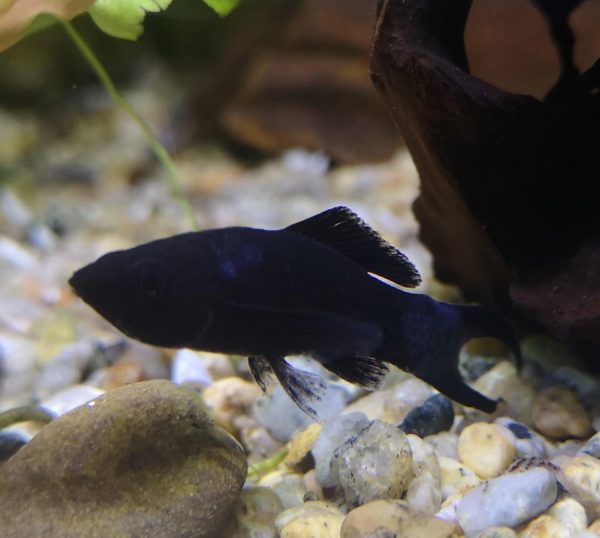
Best Plants For Black Molly Tanks
Black Molly is quite popular when it reaches to nourishing their newborn baby; therefore, providing them with a spot to hide would greatly benefit your breeding actions. But some plants would not be beneficial, and the following is the list of best plants for the tanks of Black Molly:
Worst Plants For Black Molly Tanks
- Ophiopogon jubaran
- Dracaena sanderiana
- Selaginella wildenowii
Decorations For Black Molly Tanks
Black Molly loves to live in a tank full of plants. Therefore, they generally live in community tanks. The plants also increase the rates of survival of Black Molly newborn babies by a great amount because they would be able to hide themselves somewhere in between those plants.
Nonetheless, the plants are not much beneficial for a fully grown Black Molly because they generally protect themselves by showing their contentious side to their vampire. Some suggested plants for the tank of Black Molly include the Amazon sword, Hygrophila, water sprite, water wisteria, java fern, and java moss.
Lighting For Black Molly Tanks
When it comes to lighting, it would be better if you use artificial light or sunlight as a source of light for the tank of your Black Molly. This is because the plants would need sunlight to stay healthy, and the Black Molly would also require it.
Feeding Black Molly
Black Molly generally prefers an omnivorous diet. Therefore, they eat small invertebrates, algae, and plant matter. Therefore, Black Molly would enjoy a varied diet of elevated quality live food and vegetables too.
Generally, they have green vegetables, although fish keepers would mainly nourish them with zucchini, cucumbers, and shelled peas. You could feed your fish with these vegetables two or three times a week.
Best Diet For Black Molly
Omnivore meal varieties are mainly considered as the best diet for Black Molly. However, these fish are not choosy, and they normally eat anything that you provide them.
The following are some best diets that you can provide to your Black Molly:
Algae: Black Molly appreciates the algae to have in their diet.
Invertebrates: The species of Black Molly normally consume live animals such as micro worms, brine shrimps, and daphnia.
Plants or vegetables: Vegetables and plants are also included in the diet of Black Molly. Some vegetables include cucumber, peas, and zucchini. You can feed them with vegetables 2-3 times a week.
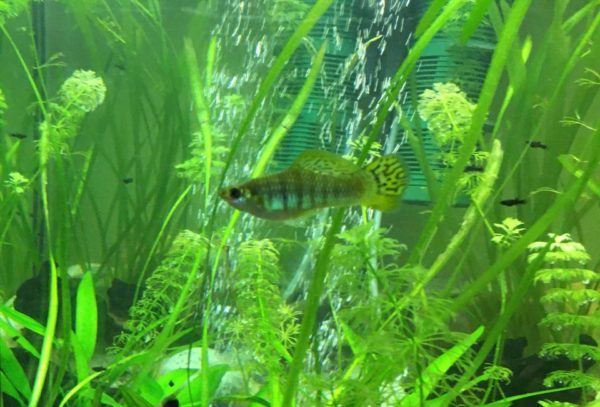
Some additional diets include flake food and frozen worms. High quality flake food and frozen foods are often considered one of the best for black molly fish.
How Often Should You Feed Black Molly?
Black Molly should typically be fed every day. Since these fish are omnivores, there are various food items you would be able to feed them. Generally, Black Molly consumes small invertebrates, algae, and plants. There exist uncountable identical diets to feed them in a tank.
Black Molly Behaviour And Temperament
All around, Black Mollies are susceptible to going fish. They are quiet, friendly, and relaxed. Most importantly, they live nicely with other fish. You should be aware that Black Molly is a kind of shoaling fish. Therefore, they would require a group of at least 4-5 fish to live with comfort and happiness.
Even a large group of fish would be nice if you can manage. For example, Black Molly roams around the tank in groups and also plays with each other.
Are Black Molly Lone Or Societal In Nature?
Black Mollies are societal in nature because these fish are friendly, calm, and a community fish who always love to inhabit cheerfully with other fish. But you should always keep in mind that the other fish should also be like Black Molly. They should not be aggressive.
Otherwise, your Black Molly would not be able to live a long life with comfort. If you keep these fish alone, they will thrive pessimistic and deserted. Therefore, it is always advised to keep a few other Black Mollies with them in a similar tank. They inhabit nicely when they have a company of other mollies.
Black Molly Tank Mates
If you are planning to add some more fish to the tank of your Black Molly, you are advised to know the ideal and bad fish for your fish tank.
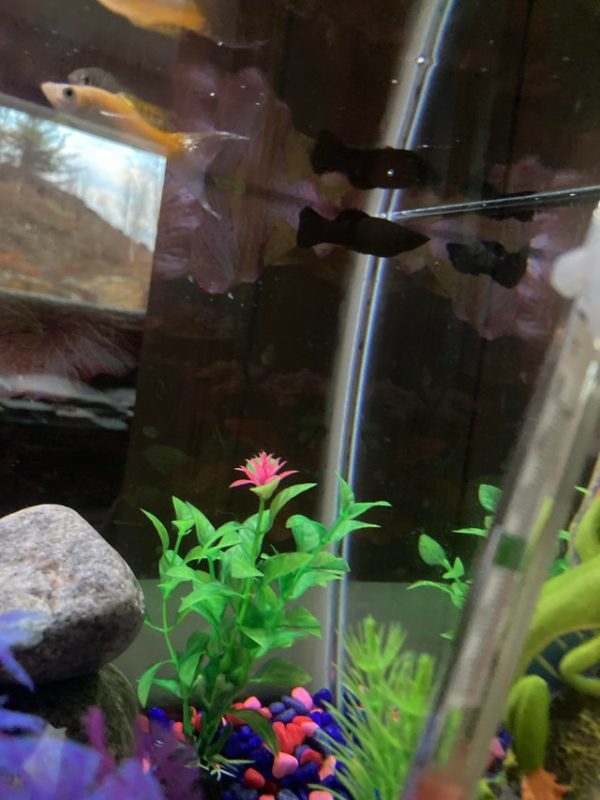
Ideal Black Molly Tank Mates
Since the Black Molly is generally peaceful, who can inhabit with other fish of identical nature.
The following is the list of the ideal tank makes for your Black Molly:
Bad Tank Mates For Black Molly
Black Molly can not live with the larger and aggressive fish in the same tank, such as the cichlids because cichlids attack on sampler fishes assuming as their source of food source, and they can even eat your Black Molly. Therefore, it is advised not to keep your Black Molly with cichlids.
It is easy to handle by providing them with accurate conditions and good tankmates and not keeping other fishes in the same tank.
Breeding Black Molly
The breeding process of Black Molly is very easy. To breed mollies, it would generally take place in a tank of your Black Molly, and you are required to maintain that at least 2:1 ratio, two females and a male.
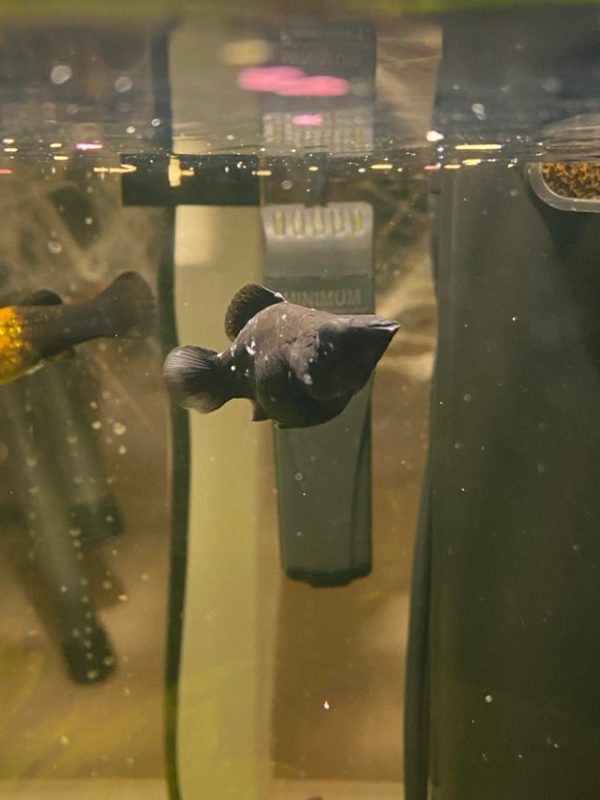
After a few days, you would observe a pregnant Black Molly. It is very easy to identify a pregnant Black Molly because you can see a dark gravid spot on their anal fin and an extensively plump belly.
Black mollies do not lay eggs because they are livebearer fish. Instead, the baby grows inside the female mollies, which is why the female mollies normally has an extremely high survival rate.
When the male and female Molly fish, Black Molly impregnates the female Black Molly with a group of sperm on his gonopodium, which is transmitted to the female duct.
Generally, the gestation period of pregnant mollies is about seven to eight weeks; after that, the female would deliver near 100 newborn babies. So if you talk of average, they deliver somewhere from 35-99 babies.
If you wish that the baby should have a high survival rate, you are required to keep your female Black Molly in a different tank for the process of delivery. However, you should be aware that Black Molly generally eat their fry. Therefore, it is advised to remove the babies from the tank of female Black Molly.
When it comes to food, newborn bodies do not expect any special treatment; therefore, from their birth, they would eat the food that a fully grown Black Molly eats. Therefore, they are generally provided with fry fish foods, micro worms, and baby brine shrimp.
Black Molly Breeding Level
- Easy
Black Molly Sexual Dimorphism?
To distinguish between male and female Black Molly, we see the size. The female Black Molly is generally large with a visible chubby abdomen. However, the great stunning aspect by which it would be easy for you to identify the male mollies from the female Black Molly is with the anal fin. An anal fin of the male Black Molly is in the tube shape, whereas the female Black Molly has a triangular one.
Black Molly Common Diseases And Their Treatment
Black Molly is a fish that is generally healthy with a handily negotiated immune.
The following are some Black Molly diseases:
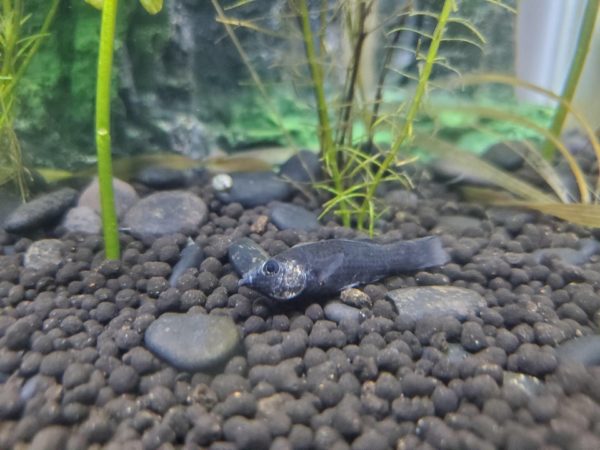
Molly Disease
It is a disease that is common with the Black Molly. Molly disease can be caused by the poor conditions of living and the incorrect parameters of water. Once a Black Molly suffers from this disease, it makes them less energetic, and they would only swim in an area.
Treatment
You should govern and control the water conditions of a tank for the requirements of the Black Molly and nourish them adequately. Hence, your Black Molly would become active again and would start to swim.
Dropsy
Dropsy is generally found in a Black Molly with an undermined immune. The poor conditions of the tank can cause this disease. Because of this disease, a lot of liquid gets stored in the stomach of Black Molly. Nonetheless, it ultimately begins to dissipate to other parts of the body.
Treatment
The treatment of dropsy is quite complicated to tackle. Therefore, quarantine would be the best option for the infected Black Molly.
Fin Rot
Fungal or bacterial illnesses cause fin rot. Nonetheless, feared and unhealthy fishes are highly sensitive, especially when the smaller Black Molly is kept with large contentious cichlids. It results in the tails and fins glancing bored and ragged.
Treatment
There is only one treatment for fin rot that is quarantine. Therefore, you are required to keep your infected Black Molly in a different tank and provide them special treatment.
Facts About Black Molly Fish
- Black Mollies are generally friendly and quiet. But the male Black Molly you can not guarantee can sometimes become contentious with the other tank mates.
- Black Mollies need at least a tank of 30 inches.
- They grow in slow-moving streams.
- They are not defensive for their babies, and they usually eat their newborn babies.
- Their babies can swim instantly after their birth.
- You can decorate the tank with some plants to increase the survival chances of newborn babies.
- The size of female Black Molly fish is quite larger than the size of male Black Molly.
Is Black Molly Fish Right For You?
Black Mollies are a considerable option for a community tank. You are just required to keep ideal tank mates. You should prevent big and contentious fish. The health of Black Molly fish is also pendant on the tank conditions, required to be in the best range.
Black Molly fish can live in many conditions of the water. You would not face difficulty with their food because they can eat different varieties of food. All around, they are extremely susceptible to look after.
Frequently Asked Questions
Is It Easy To Tell Whether A Black Molly Is Pregnant Or Not?
It is very easy to identify a pregnant Black Molly because you can see a dark gravid spot on their anal fin and an extensively plump belly.
Do Black Mollies Require Live Tank Plants?
Black Mollies enjoy a tank with lots of plants, and they generally feel extremely safe if they are kept with the planted tank. This is because plants are primarily essential to increase the rate of survival for newborn babies. Since the Black Molly ear its fries, therefore, they need a place where they can hide. Thus, the plants act as a hiding spot for their young ones.
Does A Black Molly Require A Heater?
The Black Molly is a tropical fish. Hence, I prefer warmer water with a temperature range between 70 to 80°F. However, black Molly also grows in the water’s stable temperature, and immediate alterations would influence its fitness.
A tank heater grades as the great helpful strategy of retaining a stable water temperature for the tank of your Black Molly. You would be required to evaluate the tank size of your fish for selecting a heater.
Are Black Mollies Susceptible To Look After For?
Black Mollies are an extremely prominent group of fish. Most breeds are healthy and susceptible to look after, giving rise to them considerable for beginners. They do nicely in quiet community tanks. If you keep Black Mollies in a prosperous climate, they will inhabit for five years.
Do Black Molly Fries Require An Air Pump?
Yes, the fries of Black Molly require an air pump to have the right level of oxygen needed to keep up living.
Conclusion
As you would be aware that Black Mollies are healthy, they are extremely susceptible to water parameters. To start, they prefer fresh water and not brackish water, as is often thought. In addition, you are required to be very cautious of the male to female ratio because the male Black Mollies are contentious, and they could start the female Black Mollies.
You should provide them with enough space to swim and roam around the tank, and you can also decorate the tank with some plants. Overall, Black Molly is very nice and easy to keep. You would not be required to give them any special treatment as they do not need much care.
